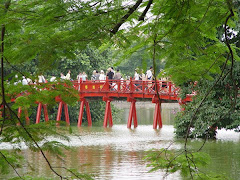
Authentic and unforgettable
Vietnam is no longer only rice fields, mines and anti-exotic foods.
Bustling, happy and proud to show its charms. Vietnam is one of the few remaining communist countries in the world, it takes a few years to open tourism, so we're anxious to show its wonders. Here tourism is not yet massive and still remain almost untouched corners, although the construction of luxury resorts on the beaches is growing at dizzying speeds.
Vietnam is no longer only rice fields, mines and anti-exotic foods. So is the boat trips on the landscape, almost unreal, of Halong Bay, long beaches of turquoise water of its nearly 3,500 km of coastline or the colorful tribes of the northern mountains. Of course, the war continues to weigh on his mind. But rather than look back with bitterness, the Vietnamese have managed to exploit that war and have become tourist attractions of the Vietcong tunnels, or places where they fought the bloodiest battles.
In a single trip can travel around the country and visit the most interesting places. Although it is a country full in length, has few kilometers wide, and you can travel comfortably by train or bus. Vietnam will learn about the two: the south, wet, floating villages of fishermen and business, and the north, cultural, artistic, with stories of great kingdoms and remote enclaves.
Ho Chi Minh, the show begins
International flights often land in Ho Chi Minh city where is the commercial and business heart of the country. Like most Asian cities, the noisy traffic and pollution are the worst, although large areas of parks and boulevards relieve the strain. Here is the Vietnamese tradition blends with modern life: sellers of crickets and put soup on the street next to Internet cafes, ciclotaxis and women wearing the shoulder with the typical seesaw baskets, along with terraces cafes and distinctly French influence.
The best way to get around is by bike (motorcycle riders will be offered to take: 2 dollars per journey or 5 dollars per hour), or ciclotaxi (3 dollars per hour). Although the buses are air conditioned and have exceptional (VND 3.5 ).
The most interesting is concentrated in District 1 or Saigon. Here are the cathedral of Notre Dame and the City, and most luxurious hotels, such as the Continental Rex and the historic. In the latter was filmed much of The Quiet American, based on the novel by Graham Greene. Also here you will find silk shops, souvenirs or electronic objects. Try one of the great ice cream Bo Gio Café (Nghiep street).
To make purchases, the market is the most popular Ben Thanh, south of downtown, but when they tour will have to bargain hard. You'll find crafts in wood and silk dresses. Behind the market, savor the typical food of Hue, in Nam Giao (dishes by VND 3).
In the area of Pham Ngu Lao, the accommodations are more affordable. Its restaurants and bars have until dawn atmosphere. In the Saigon Café can enjoy Vietnamese dishes, a kind of pancakes that it fills a pig and prawns.
There are several interesting temples and pagodas. Of the Giac Lam, west, is the oldest of the city (seventeenth century), with the same ornamentation since 1900.
On the Mekong delta
Since the Ho Chi Minh City are one step away from the long chain of rivers and canals that form the giant Mekong River delta, south of the country. The water has resulted in a unique way of life, in which everything takes place on its surface: wash, sailing, fishing ... On a day trip can visit any of the floating villages closest to Ho Chi Minh, as My Tho or Vinh Long. Although if you want to go deeper into the Delta city of Can Tho is located about four and a half hours by bus VND 15). It is worthwhile to spend the night in the village, because when they are most active markets is 6 to 9 pm .Hire a rowing boat is worth about $ 2 an hour.





